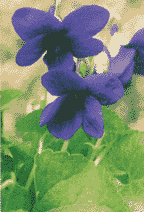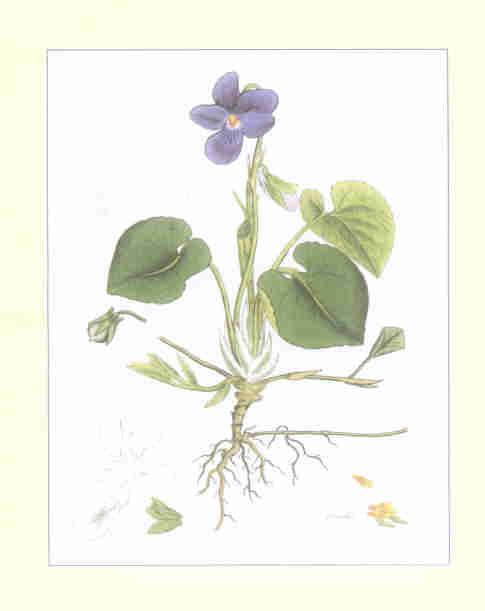|
Herb of the monnth is a regular feature of "THE COTTAGE" Violet
Planet-Venus
Element-Water
Violet in a pillow will help ease headaches away. Carrying the flowers brings a change in luck, and mixed with lavendar makes a powerful love sachet. Violet absorbs ill-will and evil spells.
Irish healing waters spell
Take equal parts of lavender, violet, and rosemary. Empower them and then boil them in a pot with about a quart of water over medium heat. When the
water is richly colored and the herbs are scenting your kitchen, drain the water off into a jar. A plain coffee filter works great for this. Place the jar in sunlight for an entire day to absorb the radiant energies of the
sun. *you can do this on a Wednesday to add the healing powers of mercury to the spell* Occasionally look at the jar and add your own energies to it.
Just before sundown fetch the jar and hold it firmly between your hands just below your naval. Feel your desire to be well filling the jar and with your minds eye see it glowing brightly as the sun. Chant these words until you have filled the jar with as much energy as it will hold.
By the herb and by the sun
wellness and I are now as one
strengthening energies now are merged.
Baneful energies now be purged
Anoint spots where illness lurks or on your belly if you are unsure where the source of discomfort lies. Or pour contents into bath water.

These sweet scented flowers always remind me of Spring.Many cultures, primarily the Celts and the Germans,
celebrate the arrival of springtime at the first
sighting of violets. The Germans further celebrate
this event with dancing and drinking of May wine, a
concoction made of wine, herbs and of course violets.
Throughout the years people have used violets for
medicinal purpose, usually in the form of a tea taken
internally.In Pakistan, it is drunk to increase
sweating and thus reduce fever. It is also reputed to
relieve anxiety, insomnia and reduce high blood
pressure. In the 17th century throat lozenges, made
with violet conserve, were used to treat bronchitis,
as well as to combat sinus congestion. Violet sugar
was a popular staple in apothecaries of the time. This
was used to treat consumption. These treatments worked
because of the antibacterial properties of the
blossoms. In addition, they contain vitamin C and A,
and an aspirin like compound.
For external treatments, violets were mixed with
vinegar to make liniments. These were used to relieve
gout, and to ease liver and spleen problems. The Celts
were known to steep violets petals in goats milk to
make a facial treatment aimed at improving ones
complexion.
When violets are used in the kitchen, it is their
candied form that most of us are familiar with. In the
Victorian times these were so popular that they were
often served as a confection for high tea. They were
also used to garnish cakes, pastries, flans and
puddings. These days people tend to use the fresh
petals more than the candied ones. I love to add them
to chilled soups (they are especially striking on
creamy spring pea soup). Try adding them just before
serving to a salad of fresh spring greens. Not only do
they add rich color, but a delicious floral taste as
well. I will often use Johnny-Jump-ups in addition to
the violets. They, along with pansies, are part of the
violet family. Their flavor and perfume is not as
strong as those of the violets, but their vivid
colors, and contrasting face-like patterns transform a
plan salad into a delightful treat. Violets are also
used to add deep color and perfumed taste to jellies,
jams, and liqueurs. Commercially available violet
water can be used to add that floral quality to cakes,
tea breads, ices, and poached fruit.
The garden is where violets truly shine. Being a
perennial, you can enjoy them year after year, in rock
gardens, pots, borders and formal gardens, almost
anywhere there is rich, moist soil, full sun (partial
shade in very hot regions) and good drainage.

|
|
|  |
|

VIOLET JELLY from Karen Garner
8 cups fresh violet blossoms*
31/2 cups boiling water
1 pkg pwdered pectin
1/2 cup fresh lemon juice
4 cups sugar
Rinse and drain blossoms; place in a glass bowl. Pour boiling water over
them and let set 2 hours, stirring occasionally. Strain and reserve
violet water, press with a spatula to extract all possible color.
Discard blossoms. Measure violet liquid; add water to equal 31/2
cups(color will be blue-green). Stir in pectin and lemon juice(liquid
will turn a lovely violet color). Pour into a stainless steel pot and
bring to a rolling boil. Add sugar and return to a rolling boil . Boil 1
minute. Remove from heat; skim foam if any, and ladle into hot jars.
Process in boiling water bath 5 min.
Yield: 5 half-pints
* may use pansy blossoms as well, be sure all blossoms are from plants
untreated with pesticides or weedkillers.
HOW TO PROPERLY PICK, WASH AND STORE
VIOLET BLOSSOMS AND LEAVES FOR CULINARY USE
1. TAKE colander or basket from salad spinner to garden.
2. PICK blossoms or leaves with ust 1/4" stem and place into container.
3. BRING container into kitchen and run cool water from the faucet
over blossoms or leaves while picking out dirt, twigs, etc.
4. PLACE cool water into a bowl and set container with rinsed
blossoms or leaves into bowl. Allow container to stay in bowl for
15 minutes.
5. REMOVE container from bowl and shake off excess water. If using
the basket or salad spinner, place basket with washed blossoms or
leaves into salad spinner and spin dry. If using a colander, wrap a
terry cloth tea towel around it and shake off excess water.
6. PLACE clean dry terry cloth tea towel on table. Put washed
blossoms or leaves on one end of towel. Bring other end of towel
over washed blossoms or leaves and pat dry.
7. PLACE washed and dried off blossoms or leaves into plastic
air tight containers or into zip-lock plastic bags and place into the
refrigerator. They will keep well refrigerated for several weeks.
Check periodically for build-up of water on the inside of container
and wipe dry if needed.
* * * * Do not wash and store blossoms and leaves all together.
Wash and store blossoms or leaves in separate containers.
how to candy flowers
1.Using either the basket of a salad spinner or colander, place blossoms in a container and rinse with cool water. Then place the container with blossoms in a bowl of cool water for 15 minutes. Drain water. Spin dry or wrap a tea towel around the colander and shake blossoms until dry
2.Spread a small layer of drying material in the assemblage box. Add flowers, more drying material, a second layer of flowers and more drying material. Close box and do not disturb for 24 hours.
3.After 24 hours, separate drying material from flowers using the plastic grid supplied with the assemblage kit. Dried blossoms stored in plastic bags or metal containers will keep for one year in a refrigerator or freezer.
4.To candy, hold blossom by quarter-inch stem and squeeze a bead of candying gel on center of flower. Spread gel with feather pastry brush. Place candied blossoms on plastic grid and allow to dry 15 to 30 minutes. Sprinkle with sugar if desired
Vyolette (Violet Pudding)
Original Recipe from Harleian MS 279:
Vyolette. Take Flourys of Vyolet, boyle hem, presse hem, bray hem smal, temper hem vppe with Almaunde mylke, or gode Cowe Mylke, a-lye it with Amyndoun or Flowre of Rys; take Sugre y-now, an putte žer-to, or hony in defaute; coloure it with že same žat že flowrys be on y-peyntid a-boue.
Modern Recipe:
Violet Pudding
2 C violet petals, trimmed and rinsed
1 C water
1 1/2 C unstrained almond milk
2 T rice flour
4 tsp sugar
1/4 tsp saffron, optional
1. In a saucepan, bring water to a boil. Stir in violet petals, return to the boil, stirring constantly, for one minute. Drain the petals in a sieve, and press out as much water as possible.
2. On a cutting board, finely mince the boiled petals, and mash them to a paste.
3. In a saucepan, over medium heat, bring almond milk to a boil, reduce heat, and simmer, stirring frequently, for two minutes. Stir in mashed petals. Stir in rice flour, a bit at a time, Stir in sugar and saffron. Continue to simmer and stir for five minutes. Serve in individual small bowls.
Serves four.
Metric, Celsius, & Gas Mark Equivalencies
____________________
Notes on the Recipe:
This recipe gives choices for just about every ingredient. I chose almond milk and rice flour because I had almond milk I needed to use up, and happened to have rice flour on hand. The "flowrys y-peyntid aboue" mentioned in the original recipe refer to the previous recipe, and were painted with saffron or sandlewood. Why anyone would further color this lovely lavender pudding with yellow or red is beyond me. Although it it not specifically mentioned, I chose to simmer the almond milk and rice flour in order to aid thickening and cook the flour. One might consider using the violet colored water left after boiling the petals to use making the almond milk.
This dish has the consistency of thick oatmeal, and is pleasantly sweet. The saffron, as well as changing the color from lavender to pale yellow-green, adds a saffron taste which covers up the delicate violet taste it originally has. (Oh well, that's what the primary source says to do, and we've got to take them at their word.) Using strained almond milk or cow milk will give it a smoother texture, but might require more rice flour to thicken it.
Violet Cooler-
About 2 tablespoons violet syrup to 1 glass of water
or soda. You can alter this to taste or desired color.
Violet Syrup-
Fill and glass mason jar with violet blossoms, cover
with boiling water, put on a lid, and let them infuse
for 24 hours. Strain the blue infusion, squeezing the
violets hard to release all the blue color. Discard
the used violets. To each cup of violet extract add
the juice of 1/2 lemon and 2 cups sugar. Bring to
boil, pour into sterilized jars and seal.
|
 |
|
|




